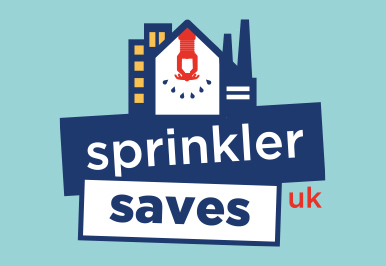
- This event has passed.
Lancashire FRS Sprinkler Activation Update May 2024
May 1

Lancashire Fire and Rescue Service (LFRS) have reported 5 incidents where sprinklers were present of which 3 activated having an impact for the period October 2023 to May 2024.
Demonstrating the benefits of sprinklers, on each occasion the
- The fire was contained, controlled or extinguished.
- No casualties or injuries reported.
- Flat Fire Sprinkler Activation
- Date of incident; December 2023.
- Time of call; 20:28.
- Use of building; Other Residential Building.
- Incident; Fire.
- Location of fire; Bedroom.
- Automatic Fire Suppression System; Sprinklers.
- Fire Rescue Service; Lancashire Fire & Rescue Service.
The premises provides a service for adults with learning disabilities and complex needs providing accommodation and personal care comprising of bungalows, houses, flats and cottages.
A small fire within a flat was successfully extinguished by the activation of one sprinkler head with fire damage confined to the room of origin, (bedroom) involving a bed mattress and bedding. No further firefighting media was required with smoke damage reported within the flat only. No injuries were reported, the cause of the fire involved a cigarette lighter.
This incident demonstrates the benefits of installing fire sprinklers.
- Providing a high level of protection for vulnerable residents of our communities as part of a package of fire safety measures.
- The sprinkler system maintained the buildings continuity of providing accommodation to other residents with minimal disruption, asset saved.
2 Industrial Waste Processing Sprinkler Activation
- Date of incident; January 2024.
- Tine of call; 15:09.
- Use of building; Industrial Processing.
- Incident; Fire.
- Location of fire; Warehouse.
- Automatic Fire Suppression System; Sprinklers.
- Fire Rescue Service; Lancashire Fire & Rescue Service.
One sprinkler head activated following a fire involving household waste within the single-storey warehouse used for the waste industry. The sprinkler system contained, controlled the fire allowing time for the onsite operative to implement the premises emergency plan. Removing the waste externally using onsite machinery allowing the waste to be turned over, extinguished. On arrival LFRS used a thermal image camera to identify remaining hotspots.
The National Fire Chiefs Council (NFCC) have reported that UK Fire and Rescue Services (FRS) attend around 300 significant fires in waste sites each year which are often difficult to extinguish requiring multiple FRS resources for significant periods of time which can have a serious impact on the local community in the short or long term, including:
- The Environmental Impact
- Public health impacts on responders and communities
- Large scale financial loses and disruption.
- Road closures
- High demand on FRS and other agency resources
FRS are fully aware of the environmental impacts of fire publishing sustainability, environmental reports with further guidance published by the government on environmental protection, providing further guidance for FRS on preventing and dealing with incidents with the potential to pollute.
Active fire protection systems, specifically Automatic Fire Suppression Systems (AFSS) should be seen as part of a holistic approach minimising fire damage as part of a greener approach from the fire sector, which is currently overlooked. The Waste Industry Safety and Health Forum (WISH) published “Reducing Fire Risk at Waste Management Sites” good practice guidance on the latest research and information available to achieve good fire risk management which includes an appendix focusing on suppression/extinguishing/fighting systems focusing on
- Importance of seeking competent advice for the installation of a fire suppression system
- The system should be proportionate to the nature and scale of waste management activities completed and associated risks.
- Choosing the appropriate fire suppression system which may include.
- Sprinklers
- Manual open deluge system
- Deluge/water spray systems
- Mobile foam trolley
- Water monitors/cannons/curtains
- The design, installation and maintenance of the proposed system is covered by an appropriate UKAS-accredited third-party certification scheme.
- Importance of liaising with insurers who may have specific requirements for fire suppression systems.
- Factory Fire Involving Machinery
- Date of incident; May 2024
- Tine of call; 03.40
- Use of building; Factory
- Incident; Fire
- Location of fire; Warehouse
- Automatic Fire Suppression System; Sprinklers.
- Fire Rescue Service; Lancashire Fire & Rescue Service
Staff tackled the fire within plant machinary used to produce felt by using hand held hose reels, activating the manual sprinkler system which contained, controlled the fire. On arrival LFRS used handheld jets to extinguish the fire, cool remaining hot spots identified using a thermal image camera. The cause of the fire was accidental due to the production process which had malfunctioned producing friction due to the machinery jamming causing smouldering which caught light. Fire damage sustained to 100m by 3m length of felt backed underlay, no juries were reported
Emergency plan
On discovery of a fire the: –
- Fire Rescue Service should be informed immediately
- Where a sprinkler system is activated, it should not be turned off until the officer in charge is satisfied the fire has been extinguished following the completion of a dynamic operational risk assessment.
The Ocado automated food warehouse fire report published July 2019 by Hampshire Fire and Rescue Authority identified that the warehouse operator, turned off the sprinkler system for 5 minutes in the hope that employees could complete extinguishment. The outcome, total loss of the fulfilment centre costing the company about £100m, 370 workers laid off
A sprinkler system can only suppress and contain or in some cases extinguish a fire thus protect a building, its occupants and assets if it is allowed to operate as designed and installed to do so.
If you want to make a difference working in the fire sector, we need your assistance……
To make sprinklers the norm and not the exception – we need the evidence. Encouraging FRS and those in the sprinkler community to promote, collate, report sprinkler activations to Sprinkler Saves UK which will help to create a central and comprehensive record of fire incidents where sprinklers played their role in containing/controlling or extinguishing the fire.
If you hear of a save report it using this link.
Sources/links
- Hampshire Fire and Rescue Authority Ocado Fire Report
- LFRS Website
- Sprinkler Saves Review 2023/2024
- Sprinkler Saves Spring Update No 4



